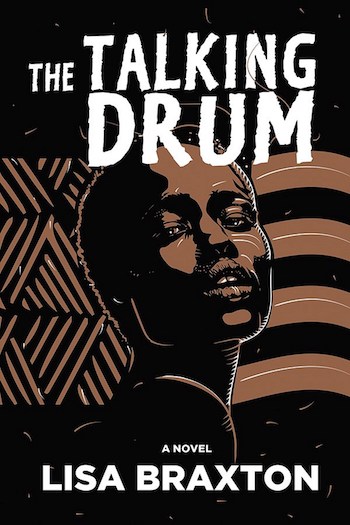Book Review: “The Talking Drum” – Gentrification From A to B
By Melissa Rodman
Despite her story’s potential for uncomfortable confrontations and revelations, the author chooses to pack the vicissitudes of her novel’s changing neighborhoods and their inhabitants’ lives into a neat and tidy package.
The Talking Drum by Lisa Braxton. Inanna Publications, 350 pages, $22.95.

Lisa Braxton’s debut novel is bookended with bookstores. One, the titular Talking Drum, is introduced in the novel’s first pages as the dream of the protagonist, Malachi Stallworth. It is his reason for returning to his hometown, Bellport, a fictionalized town near Boston, after his university denies his promotion to full professor. “Our Talking Drum is going to break it down for people, teach them about politics, economics, the Black Arts Movement,” Malachi says to his wife, Sydney, who has paused her law school studies to help him realize the venture. “It’ll be a research center with collections from famous black poets, writers, philosophers, and artists. Scholars will come from all over to do research. We’ll be quoted in research papers. Who needs Whittington University? I’ll start my own academy.”
The other, called Prologue, crops up briefly in only the last chapter, a shop that a nameless husband-and-wife team open up a few blocks away from The Talking Drum. “We’ll have puppet shows during the weekends for the kids, and then playwrights and actors can try out their works in progress before an audience on weekday nights,” the wife explains to Sydney and Malachi, when they check it out. “Are you two tourists?” the wife asks in turn. The only adjectives used to describe her are “red-haired” and “freckled.”
The 300-plus pages that separate the bookstores tell a rambling story set in the early ’70s, though passing references to the Vietnam War seem incidental rather than woven fully into the novel. The plot revolves around two bordering Bellport neighborhoods, Liberty Hill and Petite Africa, those who live there, and their transience in the face of gentrification. Specifically, the conflict focuses on the planned demolition of Petite Africa for a new waterfront development, a series of premeditated building fires that accelerate the destruction, and the tensions between black Americans, who over time have relocated from Petite Africa to Liberty Hill, and the African and West Indian immigrants who have moved into the former locale. In addition to Sydney and Malachi, there are two central couples. In Liberty Hill, there’s Della, who’s from the American South, and her meddlesome boyfriend Kwamé, who grew up with Malachi in Bellport; in Petite Africa, we meet Omar, an aspiring drummer from Senegal, and his wife, Natalie, who was raised in an affluent Washington, DC, family, as their marriage wanes.
At this historic point in time, Braxton’s storyline carries enormous resonance. On her website, she writes that the book “explores intra-racial, class, and cross-cultural tensions, along with the meaning of community and belonging.” But, despite the dramatic potential for uncomfortable confrontations and revelations, the author chooses to pack the vicissitudes of these changing neighborhoods and their inhabitants’ lives into a neat and tidy package. The sentimentality of inspiration — rather than the challenges of ambiguity — rules. The arsonists are identified, for instance, with the help of cooperative, if bland, police officers; characters portrayed as suspicious from the outset are linked to crimes by the novel’s conclusion; and two people trapped in crumbling relationships predictably find each other. In one particularly mawkish scene, an older Petite Africa resident, Omar’s uncle, who had devoted himself to saving the neighborhood, passes away — after having received Omar’s false reassurance he had succeeded.
The irony is that Braxton’s June 1 commentary for WBUR’s Cognoscenti offers the gritty voice that is weak in her novel. “I have grown tired of the unfair and inaccurate assumptions made about me. Living this way is exhausting and offensive,” Braxton insists in the piece, which is headlined “For Black Americans, ‘Social Distancing’ Is Nothing New.” “This is no way to live,” she concludes. “But it is our reality and that of so many others. America is burning and it’s no wonder. Recent deadly acts of violence against the innocent reaffirm that racial progress doesn’t seem to be in the distant future. It doesn’t seem to be a possibility at all.”
The Talking Drum, in contrast, leaves protagonists Malachi and Sydney hopeful that their bookstore will endure. “Things are looking up,” Malachi says. “Give it time. Just give it some time.” What’s more, the characters brush over the Prologue bookstore co-owner’s passive-aggressive “tourist” comment, cloaked as question: “That was strange,” Sydney mused as they left the store. “She just got here, and we’ve been here for years, and she’s acting like we’re outsiders.” “Doesn’t surprise me at all,” Malachi said. “People get territorial quick. How do you like that carrot shake she gave you?”
Melissa Rodman writes on the arts, and her work has appeared in Public Books and The Harvard Crimson among others.

superb writing by a very talented author…hope melissa continues writing and publishing as she will definitely encourage and inspire young and aspiring authors…congrarulations…marvin tokayer, formerly of tokyo, japan